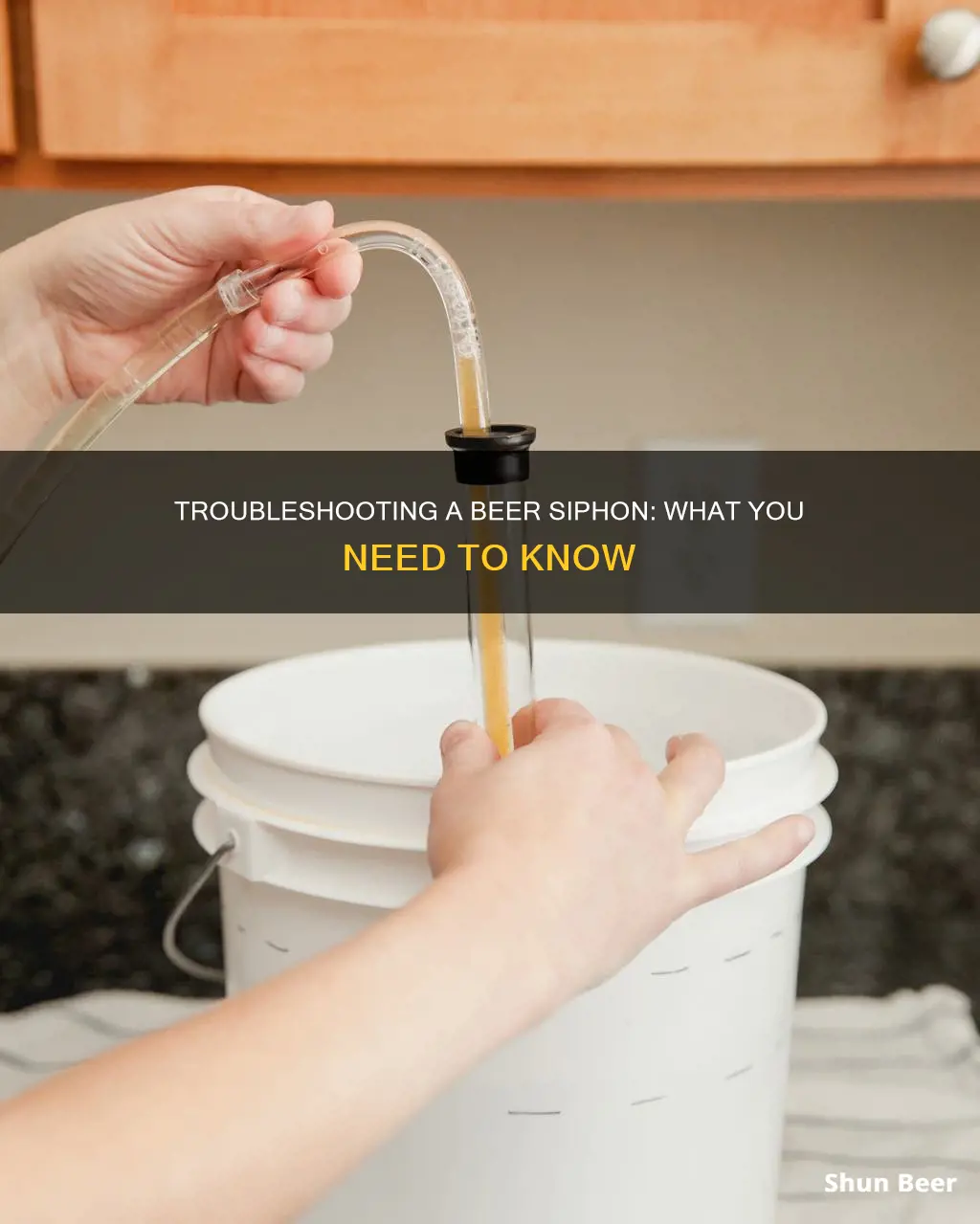
There are many reasons why your beer siphon may not be working. The most common issue is a lack of a tight seal between the tube and the cane, which can cause leaks and prevent the siphon from functioning properly. Another issue could be that the siphon is not primed correctly, which is necessary to create a pressure gradient and initiate the transfer. Additionally, the siphon may not be positioned correctly, with the outflow lower than the source, hindering the transfer of liquid. It is also important to ensure that the siphon is not clogged or plugged with debris, as this can obstruct the flow. Finally, the rubber gasket or seal on the siphon may become too slick or deformed, affecting its ability to create a vacuum and draw liquid.
| Characteristics | Values |
|---|---|
| Poor seal between the inner and outer tube | Seal may be deformed or too slick |
| Clogged siphon | Hop debris, trub, or sediment |
| Lack of sanitization | Risk of contamination |
| Incorrect tubing size | Inner dimension of tubing may be too small |
| Ineffective priming | Insufficient water or wort used to initiate flow |
| Inadequate gravity differential | Source and destination liquid levels too similar |
What You'll Learn

The tubing is not attached properly
If your beer siphon is not working, it could be that the tubing is not attached properly. This is a common problem with auto-siphons. If the tubing is not attached correctly, it can cause leaks and prevent the siphon from working properly.
To fix this issue, make sure that the tubing is pushed firmly onto the siphon cane. It should be a snug fit with no gaps or leaks. If the tubing is too loose, try using a smaller size or a hose clamp to secure it in place.
In some cases, the tubing may appear to be attached correctly, but there may still be a leak. To test for leaks, look for localized bubbles where the tubing meets the cane as the beer flows. If you see bubbles, tighten the tubing or try using a smaller size.
It's important to use the correct size of tubing for your auto-siphon. The tubing should be a tight fit on the cane, with no gaps that could cause leaks. If you're unsure of the correct size, check the manufacturer's recommendations or consult a homebrewing forum for advice.
By ensuring that the tubing is attached properly and securely, you can often fix a malfunctioning auto-siphon and get it working again.
Beer Science: Brewing Chemistry and History Podcast
You may want to see also

The butterfly valve is jammed
If your beer siphon is not working, there could be a few reasons why. One issue could be that the butterfly valve at the bottom of the central cane is jammed. This valve needs to move freely for the siphon to work. If it is jammed, there are a few things you can try to fix it.
First, check that the valve is properly assembled. There is a small, flat piece at the bottom of the larger, outer tube that snaps into place over the opening. If this piece is missing or not properly snapped in, the siphon will not work. To fix this, snap the piece back into place. Do not push on it from the bottom, as it will be difficult to put back into place.
Another potential issue could be that the tubing connected to the cane is not properly attached, causing air leaks. To fix this, try pushing the tubing further onto the cane to create a tighter seal. You can also try using a smaller size of tubing, as this can sometimes create a better seal. If this does not work, you may need to purchase a hose clamp to secure the connection and prevent leaks.
If your butterfly valve is jammed due to corrosion or buildup, you may need to disassemble and clean the valve. Soaking it in warm water can help to soften any buildup, and you can also try using a cleaning solution specifically designed for brewing equipment. Make sure to rinse and sanitise the valve thoroughly before using it again.
If none of these solutions work, you may need to replace the butterfly valve or the siphon altogether. This is a common issue with auto siphons, and sometimes the only solution is to invest in a new one.
Crafting Beer: My Career Choice and Passion
You may want to see also

The siphon tip is clogged
If your beer siphon is not working, it could be that the siphon tip is clogged. This can happen if the end of the cane does not have enough of a "screening" effect, and debris is able to enter and clog the siphon. If this is the case, you will need to clean out the clog.
To prevent clogs, some brewers attach a muslin bag to the end of their siphon to stop things from getting clogged. This can be especially helpful if you are siphoning from a vessel with a spigot, as these tend to pick up more trub.
If you are using an auto-siphon, you may also want to check that the tubing is attached firmly and pushed on far enough so that there are no air leaks.
The Magic Behind Beer Glycol Systems: Keeping Beer Cold
You may want to see also

The inner and outer tubes are not sealed properly
If your beer siphon is not working, it could be that the inner and outer tubes are not sealed properly. This is a common issue with auto-siphons. If there is not a tight seal between the tube and the cane, the siphon will not work. This can cause leaks, which will prevent the siphon from working properly.
To fix this issue, you can try downsizing the tube. The tube connecting to the cane needs to be a tight fit to create a good seal. You may need to purchase a smaller tube with a smaller inner dimension. You can also try using a hose clamp to secure the tube to the cane and prevent leaks.
Another way to fix this issue is to pour a little sanitizing solution, such as Star San, down the outer tube. This will create a vacuum and help the siphon draw without bubbles. Even if a little sanitizing solution gets into the beer, it won't cause any harm.
If your auto-siphon is still not working, there may be another issue causing the problem. It could be that the siphon is clogged, or that the fluid levels of the source and destination containers are too similar in height.
Uncapping the Secret: Beer Vending Machines Simplified
You may want to see also

The rubber gasket is too slick
If your beer siphon is not working, it could be because the rubber gasket is too slick. This can happen if the gasket has been exposed to sanitizer, such as Star San, for too long. In this case, the gasket may become too slick to create a proper seal, preventing the siphon from working properly.
To fix this issue, try the following:
- Soak the rubber gasket in warm water to soften it and then run some Star San through it.
- Ensure that your carboy is completely above the vessel you are draining into.
- Check for leaks in the system, as a leak can break the siphon.
- Try creating a vacuum by covering the discharge end of the siphon while pulling up on the siphon and then push it down with a full stroke.
- Try a few rapid pumps to create a flow.
- Make sure the tubing is attached firmly and is long enough (3-4 feet) to provide a path for the beer.
- Check that the butterfly valve at the bottom of the central cane is moving freely.
If none of these solutions work, you may need to purchase a new auto siphon or try a different method of transferring your beer, such as a traditional siphon or a spigot.
The Science of Beer Tubes: How Do They Work?
You may want to see also
Frequently asked questions
There could be a number of reasons. Firstly, check that the tubing connected to the cane is a tight fit as a loose connection can cause leaks and prevent a vacuum from forming. Secondly, ensure that the source vessel is elevated above the destination vessel so that gravity can do the work of moving the beer. Finally, check that the siphon is not clogged or jammed.
To prevent contamination, ensure all your equipment is properly sanitized before use. Avoid methods that involve direct mouth contact and use either the water/sanitizer start method or a mechanical device like an AutoSiphon.
Signs of oxidation include changes in colour (usually darker), off-flavours (often described as cardboard or stale), and a decrease in the intensity of hop aromas and flavours.







